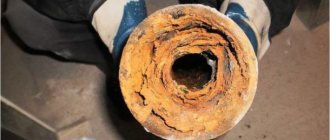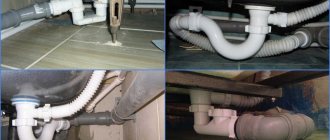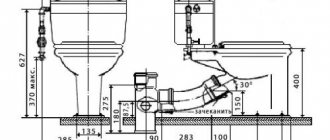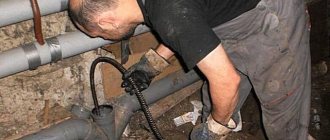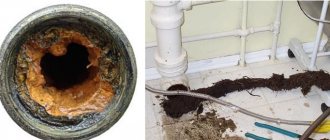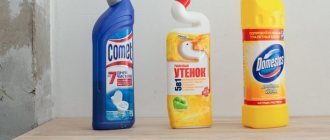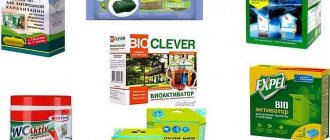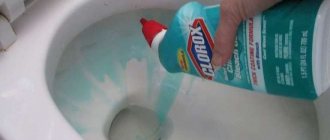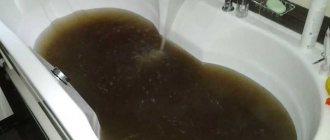A clogged toilet is an unpleasant situation that requires urgent attention. To find out how to clear a clog in the toilet, you need to determine the cause of its formation. This may be due to the formation of a plug of dirt and debris or the quality of the water.
We will tell you about effective ways to eliminate blockages in the most popular type of plumbing. The article we have presented describes in detail the chemical compositions and mechanical measures used in the fight against plugs and persistent sediment. Here you will learn how to prevent such troubles.
Causes of blockages
“Plugs” in pipes can form for various reasons. Most often they occur due to blockage of the sewer with foreign objects.
This can happen if food waste, cat litter, rags, plastic bags, and feminine hygiene items are thrown into the toilet.
Deposits of urinary stone, lime, hardened mud or other substances often cause partial or complete blockage of sewer pipes (+)
Lack of proper plumbing maintenance has a negative impact on pipes. Without regular cleaning of the system, urinary stone build-up can form inside the system, which can narrow or even block the drain. Blockages can also be caused by salt deposits, which is common in areas where hard water circulates in the plumbing system.
Folk remedies to help. Cleaning the toilet
How to remove a clog in the toilet? If no one has thrown any foreign objects into the toilet, then ordinary home remedies can come to the rescue. They will bring invaluable benefits in the formation of congestion from rust, urinary stones, fatty deposits and plaque. These folk remedies are the most common and effective.
Lemon acid. It effectively removes urinary stones and plaque on pipes. It is recommended to pour three tablespoons of citric acid into the toilet bowl. The plumbing is left in this state for three to four hours. Then the closet is cleaned with a brush and the water is drained. A pleasant bonus of such an event will be freshness in the toilet room.
Soda. If possible, empty the toilet of water. Then soda is poured into it. You will need about 250 g (half a pack). The plumbing fixtures are left in this form overnight (at least eight hours)
Then carefully drain the water, using a brush if necessary. Cleaning with soda will not only help remove plaque, but also effectively whiten the toilet.
Vinegar
To get rid of the congestion, you will need a 9% product. A liter of vinegar must be heated. The warm liquid is poured into the toilet bowl, with the water previously scooped out, and left for three to four hours. Use a rough sponge or brush to carefully clean the accessible surface. Then carefully rinse with water.
Soda with vinegar. If these products individually do not bring the desired result, then you can try to remove the congestion by combining soda with vinegar. The water from the toilet needs to be scooped out. Pour 250 g of soda into the drain. Then pour a glass of vinegar into it. Be prepared for some sizzle. After 15 minutes, when the “disturbance” of the soda ends, pour half a liter of very hot water into the toilet. But remember that you cannot use boiling water, otherwise the porcelain toilet may not withstand temperature changes. This product will get rid of plaque and eliminate grease plugs if food debris is often poured into the toilet.
Hydrochloric acid. It acts very aggressively, so it is used only in extreme cases. But it is hydrochloric acid that can dissolve the congestion formed by cat litter. You need to pour some liquid into the toilet and leave it for one hour. Then you can try to wash off the water. But if the sewer pipes are made of plastic, then the use of hydrochloric acid is prohibited. It will corrode the pipes.
There is advice to use such improvised means as bleach, Coca-Cola, bleach. They are ineffective and can only cope with small traffic jams. But they are very useful as toilet bleach.
Folk ways to get rid of blockages
To eliminate obstruction of pipes, various substances can be used. First of all, you can try to clean the toilet using basic methods.
Hot water and soda
To begin with, you should try the simplest option for eliminating the “plug” - sharply pouring a bucket of hot water at a right angle. If the water begins to drain slowly, it is better to wait a while and then pour out another container of liquid. You can speed up the process using a plunger.
The easiest way to clear a small clog in a sewer system is to quickly pour a bucket of hot water down the drain.
This method works well for blockages caused by small waste, such as cat litter, going down the drain. To increase the effectiveness of the method, you can add half a pack of soda to a bucket of hot water.
For small blockages, baking soda can be an effective aid, as it can quickly corrode organic residues and fatty deposits.
Baking soda will partially dissolve organic contaminants and fats, which will help clear the blockage.
An effective combination - baking soda + vinegar
You can also use a more complex option:
- Half a pack of baking soda is poured into the toilet drain hole, from which the liquid has been scooped, and this must be pushed as deep into the pipe as possible.
- After this, 0.5-1 cup of vinegar is poured there (carefully!). You need to wait for the reaction to complete, which releases gases that destroy the plug.
- After 20-30 minutes, 2-3 liters of boiling water or hot water is poured into the toilet (the latter option is desirable for toilets with weak connecting corrugation).
This simple method can often remove light blockages in the shortest possible time. If it doesn’t help, you can try using ready-made household chemicals.
Image gallery
Photo from
Step 1: Pouring Baking Soda into a Clogged Toilet
Step 2: Filling the toilet with hot water
Step 3: Waiting for the solution to take effect
Agent for adding to septic systems
Removing blockages using chemicals
On the shelves of specialized stores there is a large selection of preparations for cleaning toilets. Their action is based on the ability of some components to dissolve the “plug” that clogs the sewer system.
A properly selected product can completely or partially dissolve the blockage, thereby restoring the normal functioning of the sewer system.
A variety of chemical agents help manage mild to moderate congestion and also play an important role in prevention.
Household chemicals are available in the form of granules, powders, sprays, gels, and liquids. The last two varieties have the most effective effect, and the gels cause minimal harm to human health.
As a rule, the active agent in all household chemicals designed to clear congestion is caustic soda, which works well on organic matter. Other aggressive components are added to a number of drugs to enhance their effectiveness.
Chemical compositions are well suited for eliminating weak and medium blockages, especially those caused by organic substances.
These drugs are also good for preventive work because they:
- provide reliable disinfection of sanitary devices;
- maintain the sewer system in good condition, removing deposits of urinary stones, lime and other substances;
- extend the service life of plumbing fixtures, pipes, and systems.
However, it must be kept in mind that household chemicals will not cope with a sewer clog caused by a plastic bag stuck in the pipe.
Homemade household chemicals
To get rid of blockages, chemicals are often used, which almost every housewife has.
They often try to clear congestion using solutions of hydrochloric, formic, and sulfuric acids. It should be remembered: working with such preparations requires precautions, and they are also unsuitable for pipes and sewer systems made of cast iron.
Sometimes you can find a recommendation for clearing congestion using the popular dishwashing product Fairy . This product really effectively dissolves fatty “plugs”, freeing the pipe, however, this type of blockage is more typical in the kitchen and is rarely found in the pipe leading from the toilet.
Experts also oppose the use of bleach solutions and products such as “Belizna” to remove blockages in the sewer system. Such products can prevent congestion when used regularly, but they will not be able to break through it, and besides, they have an extremely negative effect on the human body.
Review of specialized preparations for cleaning the toilet
Let's consider the most popular means.
"Bagi Pothan". One of the most effective products offered in our stores. The active components of the drug are caustic soda and surfactants, which can eliminate even serious “traffic jams” in the sewer system.
“Bagi Pakkhan” is an effective remedy for removing all types of blockages. Working with it requires compliance with strict safety measures
Advantages:
- instant results;
- efficiency;
- convenient bottle with spout;
- The presence of a child-proof locking lid.
Flaws:
- quite high cost;
- the product is sold only in large containers;
- It is undesirable to use the drug in worn-out sewer systems;
- In case of contact with skin or mucous membranes, the product can cause a chemical burn, so it is necessary to take maximum precautions, protecting your hands, respiratory organs and eyes.
Directions for use: drain as much water as possible from the bowl, including the drain (at least 5 cm). Pour about 100 grams of product into the hole and wait 3 minutes, then pour a glass of hot water. Wait again for 3 minutes, then rinse the system thoroughly. When working, it is important to constantly ventilate the room.
"Mister Muscle". Gel or granules designed to prevent and clear simple congestion.
Advantages:
- sufficient efficiency - copes well with organic matter, including hair;
- perfectly disinfects pipes;
- eliminates unpleasant odors.
Flaws:
- does not remove severe blockages;
- not economical.
Method of application: the required amount of gel or granules is poured into the drain, water is added, wait 30 minutes, after which the system is washed with water.
"Selena Anticlog." A granular, inexpensive but high-quality product containing 30% soda ash.
Advantages:
- affordable price;
- good efficiency;
- neutral smell;
- no dust.
Flaws:
- the product begins to work about an hour after use;
- not always found in stores.
Directions for use: pour the substance into a drain and then pour a glass of water.
Deboucher. Highly effective gel, including chlorine, potassium and sodium hydroxides, catalysts for chemical processes. Thanks to its composition, the product can cope with both light and severe blockages.
Advantages:
- effectiveness;
- budget price;
- convenient packaging;
- There is a child lock on the lid.
Flaws:
- not suitable for metal pipes;
- not economical.
Method of application: the required amount of product (minimum 0.5 l) is poured into the sewer. It is recommended to leave it on for an hour, but the drug copes with weak blockages much faster.
Tire Turbo. A gel-like preparation containing chlorine and PVA for cleaning and preventing blockages.
The Tiret line consists of several types of products designed to remove blockages and preventive care of plumbing and sewer systems
Advantages:
- eliminates unpleasant odors;
- dissolves organic substances;
- disinfects plumbing fixtures;
- Convenient packaging with a locking lid.
Flaws:
- high price;
- cannot cope with complex congestion;
- acrid odor;
- uneconomical.
Directions for use: the required amount of gel is poured into the toilet drain hole (it is better to completely drain the accumulated liquid). After waiting 30 minutes, the drain is flushed with pressurized water.
Chirton "Clean Gutters". Granular product including caustic soda, sodium nitrate. A relatively safe and effective drug, which is packaged in disposable sachets.
Advantages:
- dissolves most contaminants well;
- no dust;
- safety for drains;
- reasonable price;
- quick result.
Minuses:
- rarely found on sale.
Method of application: granules are poured into the toilet outlet pipe, left for 15 minutes, after which the system is thoroughly rinsed with water. When used, a pungent odor appears that quickly disappears.
Sanoks "Clean drain". The product is in the form of a gel containing sodium hydroxide and approximately 30% surfactant. Well suited for the prevention and elimination of small blockages.
Advantages:
- safe for various types of pipes and sewer systems;
- budget cost;
- Convenient lid (child protection is available).
Flaws:
- low economical (the package is enough for two times);
- cannot cope with heavy congestion.
Directions for use: the required amount is poured into the drain hole, left for the specified time (15-30 minutes), and then drained with hot water.
"Floop." This drug contains caustic soda and sodium carbonate. There are two versions of this product available: with cold or hot water. The last option is more effective.
Advantages:
- efficiency - Floop" copes with such contaminants as limescale, feces, collagen fibers, fat;
- convenient packaging;
- elimination of unpleasant odors;
- quick result.
Flaws:
- relative high cost;
- the possibility of a chemical burn, which is why when using this drug it is necessary to protect the respiratory organs, hands, eyes, taking appropriate safety measures.
Method of application: granules are poured into the drain, left for 15-30 minutes, after which cold/hot water is poured in (depending on the product option). The system is then flushed with plenty of liquid.
"Mole". A popular product containing sodium and potassium hydroxides, surfactants, and acetic acid. The drug is suitable for regular sewer maintenance and copes with light blockages.
The popular drug “Mole” is best used for preventive purposes, but it can easily cope with small “traffic jams”
Advantages:
- low price;
- availability.
Flaws:
- inconvenient bottle without child lock;
- slow action.
Method of application: pour 40-120 ml of the composition into the drain hole, leave for 2-3 hours, then rinse the pipes well with water. Since Krot is produced by different manufacturers, its properties and instructions for use may differ slightly.
Effective remedies for blockages in sewer pipes and tips for choosing them are given in this article.
How can I wash it?
Domestos or Toilet Duck can easily and quickly deal with ordinary stains only if they are used regularly. To avoid the appearance of traces of urinary stones, you should clean the toilet bowl from yellow plaque with your own hands at least once every seven days.
We list several available options:
- Regular vinegar will help clean the toilet. It must be poured into water and left for about 3 hours. After this you just need to press the drain button. This simple and affordable method will allow you to get rid of minor accumulation of urinary stones after the first use.
- Citric acid is another component that allows you to remove urinary stones and limescale without wasting money and time. Two bags of citric acid are poured into the toilet and left there for 3-5 hours. After which the product is washed off with water, and the remaining plaque is removed with a brush. If after the first cleaning the expected result is not achieved, you should repeat this simple procedure.
- “Whiteness” is far from a harmless remedy, however, it is quite effective in the fight against urinary stones. Use a plunger to remove all the water from the toilet elbow, after which a bottle of “Belizna” is poured out, the toilet is closed with a lid and left overnight. In the morning, you need to wash off the product several times and evaluate the result. If desired or if the result is unsatisfactory, repeat the procedure again.
- A 33% saline solution is used when cleaning a toilet only if the plumbing fixtures are not made of plastic. Removing urinary stones using acid should only be done while wearing protective gloves, thereby protecting the skin from possible chemical burns. Pour acid generously over the dry walls of the toilet and then leave for half an hour. Before rinsing, clean the stained areas with an unnecessary brush and rinse several times with clean water. The method, although quite toxic, is extremely effective.
- Electrolyte is another method that is prohibited if you have plastic pipes. However, electrolyte is the most radical and effective in methods of cleaning the toilet from urinary stones. The electrolyte is simply poured into the toilet, left there for a couple of hours and washed off with water.
- Perhaps in every home you can find oxygen bleach, which can also be useful in getting rid of urinary stones. The product is poured onto the urinary stone, then the area is intensively rubbed with a hard brush and washed with clean warm water.
- Abrasive cleaning products such as Domestos, Komet. The method of using them is simple, although unpleasant. All the water is scooped out of the toilet, the walls are covered with the product and rubbed with a rag or sponge until crystal white. The only disadvantage of this method is that the glossy surface of the toilet may become rough due to the formation of scratches after cleaning with such means. And scratches, in turn, contribute to the rapid accumulation of plaque and urinary stone on the walls of the toilet.
- Dry oxalic acid is used more often in the chemical industry to clean the surface before applying an enamel coating. But a small amount of such acid can successfully remove dirt from the toilet. To do this, the substance is applied to a rag (the use of gloves is mandatory), with which the dirty areas are wiped. Even simpler is to pour the acid into water, clean it with a brush and rinse with water.
- Carbonated drinks such as Cola, Sprite. Although the purpose of these drinks does not at all imply cleaning toilets, as practice has shown, they cope with this task quite well. Only after this does one become afraid of what these drinks can do to a person’s stomach. A couple bottles of sparkling water are poured down the toilet. Due to the citric acid content in the drink, plaque is corroded extremely quickly.
It must be remembered that a new and expensive toilet is much easier and more profitable to keep clean. We must not forget about preventative agents that can clean the drain from all kinds of plaque and deposits.
Mechanical methods of dealing with congestion
More effective methods that can cope with complex congestion are different types of mechanical devices.
Plunger - a device for clearing blockages
A popular plumbing tool consisting of a rubber suction cup and a wooden or plastic handle. The mechanism of operation of a plunger is similar to that of a pump. The toilet flush hole is covered with a valve, and then a back-and-forth movement is made while pressing the handle.
Thanks to this, hydraulic tension is created in the system, as a result of which water and sewage are pumped out of the siphon or pipe, and the existing “plugs” are destroyed. For the best effect, it is advisable to first pour out all the water that has accumulated in the toilet bowl and only then start working with the plunger.
A plunger is a simple but effective tool that works similar to a pump. This mechanical device can deal with small traffic jams quickly and easily.
In case of complex blockages, it is advisable to close the drain holes (upper, lower) in all plumbing fixtures located in the bathroom, in the kitchen, and only then pump the water in the bowl with sharp jerks using a plunger.
If slow drainage is typical both in the toilet and in the sink with washbasin, it is advisable to repeat this procedure separately for each device, blocking the holes in the rest of the plumbing.
After removing the “plug”, for prevention and disinfection, you need to rinse the toilet by pouring 1-2 buckets of warm water with the addition of soda down the drain. The plunger should also be thoroughly rinsed or placed in a disinfectant solution.
Image gallery
Photo from
Step 1: Signs you need to use a plunger
Step 2: Preparing the room for cleaning the plumbing
Step 3: Selecting and preparing a plunger for punching
Step 4: The process of cleaning the toilet with a plunger
The cable is a means to solve complex problems
One of the most effective ways to unclog a clogged system and toilet is a plumbing cable, which is used by both amateurs and professionals. This is a metal cable with a rotating handle.
The tool has various modifications (rope, spring, spring-wound), the length of which can vary between 1.5-60 m.
A plumbing cable is a rigid metal bundle, at the end of which an additional device is attached to break up the blockage.
A pointed nozzle, a metal brush or a wire spiral is attached to the end of the cable, specifically to destroy the blockage. The cable is released into the toilet until it stops and the handle is rotated clockwise, due to which the device passes into the water seal.
The diagram shows how deep the cable penetrates into the toilet outlet pipe. Thanks to this, it is able to clear even complex congestion
If an obstacle is detected, there are several ways to clear it with a cable:
- If the cable is partially immersed in water, it may rest against the back of the disc bowl. In this case, it is necessary to make pushing movements until the tool slides along the inner surface of this area of the toilet.
- If, while moving, the cable hits the vertical wall of the riser, you must use special equipment.
- With a direct release toilet, the cable is pushed along the horizontal sewer pipe until it touches the inside of the riser. If you feel difficulty in moving, then its tip has encountered a blockage. Then it’s worth performing back and forth movements, pushing the tool into the riser.
It is most convenient to work with a cable in pairs, which allows you to better control the process. Upon completion of the manipulations, you should clean the system by rinsing it well with water and disinfect the instrument.
Image gallery
Photo from
Step 1: Preparing the plumbing cable for use
Step 2: Inserting the cable into the hole in the plumbing bowl
Step 3: Breaking the blockage with a plumbing cable
Actions with a rope stuck inside the toilet
Devices made from scrap objects
If there are no special devices at home, you can use a plastic drink bottle or other homemade devices.
If there is no plunger or plumbing cable, they can be replaced by a regular polymer bottle with a screwed cap and a cut bottom
In the first case, the lid of a regular plastic bottle is tightly screwed on and the bottom is cut off. This device is then used in a similar way to a plunger. After use, the homemade device must be discarded immediately.
You can also make a “pusher doll” out of a stick and unnecessary rags, with which you try to “knock out” the blockage. Alternatively, you can quickly make a homemade plunger from a children's rubber ball, cut in half and attached to the handle.
Manual drain cleaning
Not very pleasant, but in some cases a necessary option. As a rule, this method is used if the owners know that a blockage in the toilet is caused by an object (a children's toy, an apple) getting into the drain.
You will have to put on rubber gloves and scoop out the contents of the bowl, and then try to feel with your hand the object that is pulled out with your fingers or with a wire whose end is bent with a hook.
It is dangerous to use a plunger, since it will only drive the object deep into the sewer system, from where it will be difficult to get it out.
Preventing sewer blockages
A blockage is a very unpleasant thing that is easier to prevent than to deal with.
For prevention, it is important to constantly monitor the condition of the drainage system:
- Avoid the appearance of rust, salt and other deposits by regularly cleaning the bowl and, as far as possible, pipes using modern disinfectants.
- Be sure to regularly clean the toilet bowl and drain using a plumbing brush.
- Do not throw foreign objects or cat litter into the toilet.
- Do not allow various types of construction waste to enter the sewer system during repair work.
- When installing equipment, use sewer pipes of the required diameter.
If all these rules are followed, the likelihood of blockages will be greatly reduced.
Preventive measures
Proper and timely care of your plumbing will help you avoid blockages, traffic jams and other troubles. It should be remembered that large objects should not be flushed down the toilet, including food debris, feminine hygiene products, cat litter, and grease from frying pans. In addition, it is important to regularly carry out the following actions:
- Clean the drain daily with hot water or detergent. It takes 1-2 minutes, but saves several hours in the future.
- Once a month, clean the plumbing with detergents or household products.
- Do not put paper and napkins into the bowl, but use a basket for this.
To forget about such a problem as a clogged toilet, you need to follow simple rules.
Simple preventive measures will help you avoid blockages and waste of time and nerves on their removal.
Conclusions and useful video on the topic
From the video you will learn how to clean pipes and a clogged toilet:
If you are unable to eliminate the cause of the blockage yourself, it is important to immediately contact a plumber. Clearing complex sewer blockages requires specialized knowledge, skills and professional equipment.
Are you trying to fix a similar problem yourself? Offer an effective solution to the issue, share your experience in dealing with a clogged toilet. You can leave comments on the article and ask questions in the form below.
